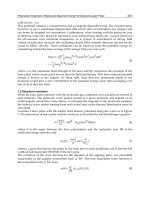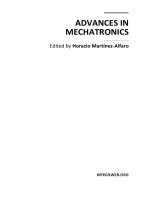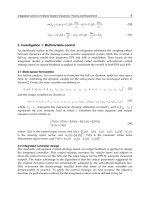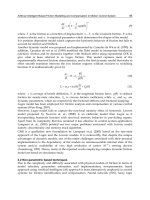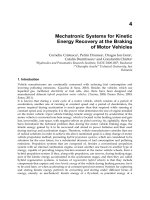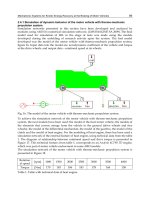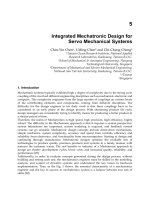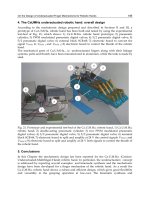Advances in Mechatronics Part 13 docx
Bạn đang xem bản rút gọn của tài liệu. Xem và tải ngay bản đầy đủ của tài liệu tại đây (3.74 MB, 20 trang )
Surface Reconstruction of Defective Point Clouds Based on Dual Off-Set Gradient Functions
229
hole
overlapping regions
hole
overlapping regions
0 0 1 0 0
0 1 1 1 0
1 1 1 1 1
0 1 1 1 0
0 0 1 0 0
(a) (b) (c)
(d) (e)
(f) (g)
Fig. 4. Generation of off-set surfaces. (a) Defective point clouds. (b) Voxel image. (c) Disk
shape with
333size. (d) Close crust. (e) Image after filling inside. (f) Outside function. (g)
Inside function.
is water-tight. If the crust is not close, the flood-fill operation could cover the whole space
grids. Let
f
F donates the function after the flood-fill step,
all
F
denotes the whole volumetric
image, if
f
all
FF, the crust is not close. Thus, image
F
needs be dilated and check again.
Due to the voxelization and the choice of
B
, the dilation of examples in the paper
performed less than 3 times (except Fig.18). The resulting image is shown in Fig. 4 (e) by
iteratively performing the operation. And then the erosion operation is used to restore the
image, expressed by
(,,) min ( , , ) (,, )
out f f
f
x
y
zxu
y
vz w uvw FB F B (4)
structuring element
B
and the erosion times must be the same as the dilation step otherwise
it cannot recover the image. The restored image is treated as the outside function
out
f
(Fig. 4 (f)).
The inside function
in
f
is generated by dilation from inside part as follow, where the
intermediate result
f
F is adopted,
Advances in Mechatronics
230
()
in f
f
FFBB (5)
where
B is the same as in the process of constructing
out
f
. The result of
in
f
is shown
in Fig. 4 (g).
As shown in Fig.3 (b) the relative functions
out
f
and
in
f
construct a narrowband. This process
needs not complex computation just set operation. Theoretically, this step could be also used
in the situation of non-manifold surface, which divides the space into more than two pieces.
But it needs to confirm the start points for flood-fill operation artificially, because without
any pre-information, the topology of point clouds is not unique and may be confused. In
industrial application, this kind of products is a rare case.
Actually if many small details of points need to preserve,
out
f
and
in
f
could be updated on
non-uniform grids by a subdividing process with two general steps (Fig.5). In Fig.5 (a), the
dotted lines represent the dual functions on rough uniform grids, the real line represents the
old resulting surface. First, the grid containing more than two points is subdivided as next
level of 8 neighbor grids (see Fig.5 (a)) and the points within are inserted in new subdivided
grids. The iterative subdividing process stops until no grid contains two or more points.
Then, a local flood-fill process is performed in the new subdivided grids. For instance, for
generating new inside function
in
f
, the filling operation starts at a node of last level known
to be inside (real rounds at nodes in Fig.5 (b)). It performed on each subdivided levels
hierarchically and stop until all the inside/outside of new subdivided grids are confirmed.
Since
in
f
and
out
f
are digitally based, they could be easily updated. With non-uniform grids,
the new resulting surface (red dotted line in Fig.5 (b)) could preserver more details.
However, the subdividing process is not often necessary because like other reconstruction
methods based on fitting local primitives, the details of corresponding resulting surface are
influenced deeply by the noise. So it could be used at the situation that the point clouds are
dense enough without much noise.
inside function
outside function
outside
inside
(a) (b)
Fig. 5. Process of constructing subdivided grids. (a) Subdivided grids and old dual
functions. (b) Updated dual functions.
3.2 Construct weighted gradient fields
in
f
and
out
f
generated in last step are rough approximation to the off-set surface of
() x
due
to the noise influence. This step is to reduce the affection and reconstruct a smooth and
Surface Reconstruction of Defective Point Clouds Based on Dual Off-Set Gradient Functions
231
reasonable off-set surface. The weighted vector median filter in 2D grey image processing is
extended into 3D space. Since
in
f
and
out
f
are Heaviside-like functions, they need to
transform as gradient fields by two sub-steps. First, they are transformed as monotonic
function by blurring their boundaries within neighbor space. Second, the corresponding
gradient functions are computed. In this paper, a 3 3 3
kernel of Gaussian
function (,,)Gxyz with standard deviation
is employed to produce non-integer node
values,
222 2
(,,) (1/ 2 )exp(( )/2 )Gxyz x y z
(1)
in
f
and
out
f
are thus transformed as,
in in
out out
gfG
gfG
(2)
The blurring results by Eq.(2) are shown in Fig. 6. It shows that noise influence still exist in
some place.
in
g and
out
g are then transformed as gradient functions
in
v and
out
v .
/
/
in in in
out out out
gg
gg
v
v
(3)
(a) (b)
Fig. 6. Construction of gradient functions. (a) Outside gradient function. (b) Inside gradient
function.
Although the computation of Eq.(3) amplifies the noise influence, it is much suitable of
weighted vector median filter to reduce the noise in function
in
v
and
out
v
, which is more
effective and robust to denoise in image process (Barner et al. 2001). The algorithm needs to
define the metric and the relationship between the elements in neighbor grid region.
Let
,1,2
i
inv
represents the vector in a neighbor region
, which contains n vectors. The
metric ( , )
i
j
M vv of two vectors
i
v
and
j
v can be defined as the
p
L norm of the difference
between them,
(, ) (, )
i
jp
i
j
i
j
p
MLvv vv v v (4)
Advances in Mechatronics
232
The relationship between each vector, represented as
(, )
i
j
R vv
should changes according to
the metric. According to (Nie & Barner 2006), it can be expressed by following constraints,
(,) 0,(, )1
(,) ,(,)0
(,) ( ,),(, ) (,)
ij ij
ij ij
i
j
kl i
j
kl
MR
MR
MMRR
vv vv
vv vv
vv v v vv v v
(5)
Usually, ( , )
i
j
R vv can adopted the Gaussian function coupled with metric ( , )
i
j
M vv ,
22
(,)2
(, )
ij
M
ij
Re
vv
vv (6)
(,)
i
j
R vv is adopted to modify the median vector in local region
for local geometric
constraints. Therefore, the output of the modified vector
f
v is defined as
1
1
(, )
()
(, )
n
iim
i
f
n
im
i
R
W
R
vvv
vv
vv
(7)
where
m
v
is the median vector defined by,
1
arg min ( , )
n
mi
i
M
vvv
(8)
The neighbor region
is set as 5 5 5
neighbor space, a little larger than the structuring
elements
B in last step. Because if it is less than B , the noise could not be reduced, if it is too
large, the computation is not efficiency, since it needs to compute the each vector
i
v to all
other vectors in neighbor region of
n elements to find the median vector
m
v . Norm
p
L is
adopted as
2
L in the rest of the paper. According to the convolution, function
in
v and
out
v are
redefined as
in in
out out
W
W
vv
vv
(1)
in
v and
out
v are visualized by extracting the zero-level lines from their integer function
in
d
v and
out
d
v (Fig.7).
The details of the results demonstrate that the noise influence is effectively rejected
according to the comparison of one noise region (on the right in Fig.7 (a) and Fig.7 (b)). The
overlapping regions don’t lead any jagged errors or self-intersection. Actually, only one of
the dual functions, either
in
v or
out
v , can be used as for the surface reconstruction by
gradient computation with large kernel size. But the holes can not be filled flatly, some
concave parts exist (at the bottom in Fig.7 (a) and Fig.7 (b)). Since outside function
out
f
and
inside function
in
f
are obtained by erosion and dilation respectively, which are opposite
with each other, the reasonable resulting could be obtained by blending the dual functions.
Surface Reconstruction of Defective Point Clouds Based on Dual Off-Set Gradient Functions
233
after filter before filter
after filter before filter
(a) (b)
Fig. 7. The final gradient fields and details. (a) Inside gradient function. (b) Outside gradient
function.
3.3 Formulate and solve PDE
Based on the dual gradient functions, a minimal energy model is proposed. The gradient of
resulting surface
()
x should best approximate a combined field generated in last step. The
differences between them are defined as the square of
2
L norm. The object function is
expressed as
2
12
2
()
in out
in out
Ed
vv
vv
(2)
where
1
and
2
are positive constants for adjusting the influence of
in
g
and
out
g
to
. Thus,
the corresponding Euler-Lagrange equation is derived as,
12
()0
in out
in out
vv
vv
(3)
The boundary condition is
0
V
. Actually, this method treats the two gradient functions
in
v and
out
v equally, thus, the positive parameter is set as
12
1
. The PDE is a typical
Poisson equation, there are many methods to solve the classic equation. This paper adopts
Fast Fourier Transform (FFT) method, since it only needs to transform the equation as
Fourier series and solve a linear equation.
To visualize the resulting surface, the level set valve of
should be confirmed. Theoretically,
zero-level set is the object surface, however, due to the weighted combination, the valve of
the object level set changes little from zero. This paper adopts the approximation valve of
the positions of the input samples. It is confirmed by evaluating
at the sample positions
and using the average of the values for iso-surface extraction,
3
1
1
{()} ()
m
i
i
p
Rp with p
m
(4)
where
is iso-value, P is the point sets. The marching cubes method (William & Harvey
1987) is employed to extract the iso-surface. The details are shown in Fig. 8.
Advances in Mechatronics
234
holes are filled reasonably
noise influence is reduced
overlapping regions are handled
Fig. 8. Result surface and details.
The dual functions
in
v and
out
v give reasonable constraints to guarantee the global shape of
the resulting surface. The parameters
12
1
make the overlapping regions and holes
naturally adopt the flat result. Compared with the result in Fig.7, besides the noise
influence, the holes are filled flatly and the surface patch in overlapping samples is much
reasonably.
4. Numerical examples and analysis
In this paper, the implementation employs PC CPU 2G Hz and 1G main RAM with the soft
platform Matlab coupled with C++ API. To demonstrate the effectiveness and robustness,
this paper takes the point clouds series sampled from a fan disk model (Fig. 9 (a)) as the
examples. The point clouds (Fig. 9 (b)) are sampled with uniform density 0.01mm , thus the
length of the voxel is set as 0.01hmm
.
(a) (b)
Fig. 9. Fan disk point clouds without noise. (a) Geometric model. (b) Original point clouds.
This paper gives all the situations of the defective samples as shown in the left row of Fig.10,
including sparse point clouds (Fig.10 (a)), point clouds with random noise (
2
(0,0.1 )
r
N ,
Fig.10 (c)), point clouds with holes (Fig. 10 (e)), with overlapping samples (Fig.10 (g)) and
the hybrid point clouds (Fig.10 (i)) which contains all the defective situations. The point
clouds with holes are generated by reducing some random places on the original samples
(Fig.9 (b)). The overlapping samples are generated by mis-registration (the error is set
as 0.05mm ) which often make the resulting surface have some scallops. The right row is the
corresponded resulting surfaces and the details (from Fig. 10 (b) to Fig. 10 (j)). The propose
Surface Reconstruction of Defective Point Clouds Based on Dual Off-Set Gradient Functions
235
method is much convenient to implement, the hybrid defective samples (Fig.10 (i)) needs
not any extra steps, the holes of resulting surface (Fig. 10 (j)) are filled smoothly and no self-
intersections exist in overlapping samples.
(a) (b)
(c) (d)
1
2
3
4
1
2
3
4
1
2
3
4
1
2
3
4
1
2
3
4
1
2
3
4
1
2
3
4
1
2
3
4
(e) (f)
1
2
1
2
Overlapping regions
1
2
1
2
Overlapping regions
1
2
1
2
1
2
1
2
(g) (h)
Advances in Mechatronics
236
(i) (j)
Fig. 10. Examples of fan disk. (a) Sparse point clouds. (b) Resulting surface of sparse point
clouds. (c) Noisy point clouds. (d) Resulting surface of noisy point clouds. (e) Point clouds
with holes and details. (f) Resulting surface of (e) and details. (g) Point clouds containing
overlapping regions and details. (h) Resulting surface of (g) and details. (i) Hybrid defective
samples. (j) Resulting surface of Hybrid defective samples.
11
22
33
44
1
2
3
4
11
22
1
2
(a) (b)
Fig. 11. Error destruction with color map. (a) Result of point clouds with holes. (b) Result of
point clouds with overlapping samples.
The numerical details of all the examples about fan disk are shown in Table.2. The time
complexity of the method generally includes three main components, dilation-erosion
(
()ON ), weighted vector median filter ( ()Om ) and FFT ( (lo
g
())ON N ). As weighted vector
median filter adopts a fixed window of neighbor space, its time complexity is only relevant
to point number
m , which is far less than grid number N . Therefore, the computing time
mainly depends on the resolution of space grids, which is related with the point density.
Since the point clouds are all generated from same original model, the computing time is not
difference too much except for the sparse points. The whole time of all the examples is
within 80 seconds. This paper adopts the average errors (between resulting surfaces and
point clouds) as the main accuracy standard for evaluation. The average errors of all
examples are lower than 0.05mm , which is accuracy enough to satisfy the practical
application. The results also demonstrate that the noise and overlapping regions can cause
more errors than other defective samples since they often influence some sharp corners of
resulting surface. Besides the average errors to the point clouds, this paper gives the
comparison between the resulting surface and original model (Fig.9 (a)) with error
distribution of colour map (Fig.11) Fig. 11 (a) is the result of point clouds with holes. the
Surface Reconstruction of Defective Point Clouds Based on Dual Off-Set Gradient Functions
237
hole are filled smoothly and reasonably, thus the errors of the holes are nearly the same as
their neighbor regions. Fig. 11 (b) is the result of point clouds with overlapping samples. Of
course, the errors are larger than other regions due to mis-registration, but he overlapping
samples are merged reasonably and they don’t cause any impulse changes in resulting
surface, thus their errors change smoothly.
Point clouds of fan disk
Number of
points
Grid
resolutions
Compute
time (s)
Average errors
(mm)
Original points 100448
163 163 163
75.6355 0.014
Sparse points 10908
126 88 76
48.6522 0.031
Noisy points 100448
163 163 163
74.9853 0.045
Points with holes 99155
163 163 163
75.6654 0.016
Points with overlapping 125567
163 163 163
76.1203 0.035
Hybrid defective samples 124221
163 163 163
75.2368 0.046
Table 2. Details of the example about fan disk model.
In fact, the length of voxel could not follow the density of point clouds strictly, but if it is not
set suitably, the resulting surface becomes over-fit or over-smooth cases. Two examples with
“bad” grid size are shown in Fig. 12, which are both the resulting surface of noisy point
clouds (Fig. 10 (c)). Fig. 12 (a) is the over-fit resulting example with grid
0.004hmm
. Fig. 10
(b) is the over-smooth case with larger grid size
0.3hmm
. This paper suggests a suitable grid
size as
0.8 1.2
p
hp , where
p
is the average density of point clouds.
1
2
1
2
(a) (b)
Fig. 12. Reconstruction with different grid size. (a) Resulting surface and details with smaller
grid size. (b) Final resulting surface with larger grid size.
Beside the theoretical model of fan disk, this paper also adopts some practical examples
since in real case the overlapping regions and holes are complicated. The following practical
point clouds are scanned by the hand-held digitizer (type number: Cimcore Infinite Sc2.4).
Fig.13 (a) shows the point clouds of a mechanical part. It is the example containing much
overlapping samples (details labeled in circles). The resulting surface (Fig.13 (b))
demonstrates the overlapping regions can be reasonably fitted and smoothed. The next
example is the point clouds of piston rod. In the middle bottom of Fig.14 (a) is the points
Advances in Mechatronics
238
within a section plane, where overlapping samples exist. The detail of a hole is shown in the
lower right (Fig.14 (b)). In practice, the sparse points often exist in un-uniform point data.
Fig.15 (a), point clouds of engine outtake ports from an automobile in real case, shows the
situation. Because the density is not uniform, this paper could adopt the average density to
decide the grid size. The result of smooth and water-tight surface is shown in Fig.15 (b).
1
2
3
1
2
3
1
2
3
1
2
3
(a) (b)
Fig. 13. Reconstruction of mechanical part. (a) Point clouds and details. (b) Final resulting
surface and details.
(a) (b)
Fig. 14. Reconstruction of piston rod. (a) Point clouds and details. (b) Final resulting surface
and details.
(a) (b)
Fig. 15. Reconstruction of engine outtake ports. (a) Point clouds and details. (b) Final
resulting surface and details.
Surface Reconstruction of Defective Point Clouds Based on Dual Off-Set Gradient Functions
239
Fig.16 shows the example of an ancient cup which contains much free-form details for
preserve. Since the point clouds have no holes, just little noise but many overlapping
samples due to multi-scanning, the non-uniform grids are employed. Detail 3 in Fig.16 is the
little noisy part, Details 1 and details 2 are the overlapping regions because the cup bottom
is hard to scan within only once. The point clouds are density enough, the structuring
element
B
could be chosen with small size. In the example, the structuring element size is set
as
111, just only for merging overlapping samples. The resulting surface and details are
shown in Fig. 16 (b). The resulting surface is smooth, the noise influence and overlapping
regions are reduced. Although only fewer small details are blurred due to the dilation-
erosion operation, but most shape features are preserved.
1
2
3
1
2
3
1
2
3
1
2
3
(a) (b)
Fig. 16. Reconstruction of ancient cup. (a) Point clouds and details. (b) Final resulting surface
and details.
(a) (b) (c)
Fig. 17. Triangulation of mechanical part. (a) Triangular meshes. (b) Details of meshes. (c)
Meshes after artificial holes-filling.
Because this method needs not any triangulation, the efficiency is highly improved more
than the methods which need triangulation. The mechanical part (Fig. 13 (a)) is taken as an
example for comparison. This paper uses Geomagic (version 8.0) which is a widely used
Advances in Mechatronics
240
commercial software utility in reverse engineering domain. It performs reconstruction based
on building triangular meshes, as most conventional methods do. The result is shown in Fig.
17 (a). As the influence by the noise and non-uniform regions in the point clouds, it is
difficult to construct a water-tight triangular mesh (Fig. 17 (a)). Some holes and rough place
exist (Fig. 17 (b)). Thus, the artificial work of filling holes has to be performed (Fig. 17 (c)).
The time of triangulation and reconstruction by this method is given in Table 3, where the
time of Goemagic contains no artificial filling time. The comparison demonstrates that if the
number of point clouds increase, or much noise exist, the triangulation time increases more
than the time of surface reconstruction by this method.
Number of points Time of triangulation (s) Reconstruction time of this method (s)
60000 30.3324
——
120000 66.5633
——
250000 81.9623
——
500000 171.9932
——
550000 180.6897 76.5367
Table 3. Time comparison between triangulation and reconstruction of this method with
different sample point clouds.
The proposed method is especially useful to deal with the point clouds of “bad-scanning”
like the example shown in Fig.18. It is a resin mould of engine intake ports from an
automobile in real case (Fig. 18 (a)) and the original CAD model is shown in Fig.18 (b).
Because the resin mould is too soft to fix, the point clouds by multi-scanning have larger
errors of mis-registration (e.g. labeled by circle 1 in Fig. 18 (c)) than all examples above. The
holes (e.g. labeled by circle 2 in Fig. 18 (c)) are much large and the noise appears
everywhere. The points are much disadvantageous to obtain the specific information,
especially triangular mesh with high quality. This paper gives the results by two typical
methods based on Delaunay triangulation. Fig.18 (d) is the triangular mesh reconstructed by
Raindrop Geomagic. The defective samples obviously influence the results: the holes need
to be filled by other artificial work and the overlapping regions lead to some jagged
triangles. Fig. 18 (e) is the resulting surface by power crust method (Amenta et al. 2001).
Although the resulting surface is watertight, the surface is rugged and overlapping regions
are self-intersect. The two results need some complex post-process. Fig. 18 (f) shows the
resulting surface by level set method(Zhao et al. 2000), which need no specific information.
The resulting surface is much better, but the surface is not smooth enough, especially the
regions of holes. The final surface by this method is shown in Fig. 18 (f). This method
guarantees a smooth and water-tight surface, holes are filled flatly and no self-intersections
in overlapping samples. The “bad-scanning” samples need more dilation-erosion
operations, the resulting surface is acceptable and convenient for certain post-process. But if
the input data have too large holes or serious overlapping samples, the details of the
resulting surface may be blurred due to too many dilation-erosion times.
The numerical details of the practical examples are shown in Table. 4. Since the point data of
engine intake ports contain so many defective samples, the resulting surface has the largest
average errors than other examples. Even if the ancient cup example has nearly 1 million
points, the compute time is only 90 seconds.
Surface Reconstruction of Defective Point Clouds Based on Dual Off-Set Gradient Functions
241
1
2
1
2
overlapping regions
holes
(a) (b) (c)
1
2
overlapping regions
1
2
holes
(d) (e)
(f) (g)
Fig. 18. Example of engine intake ports. (a) Resin mould of engine intake ports. (b) Original
CAD model. (c) Point clouds and details. (d) Triangular mesh by Geomagic software. (e)
Triangular mesh by power crust method. (f) Resulting surface and details by level set
method. (g) Resulting surface and details by proposed method.
Name of point clouds Number of points Grid resolution Average errors (mm)
Mechanical part 537925
136 188 154
0.022
Piston rod 412847
242 106 150
0.021
Engine outtake ports 98175
66 63 41
0.035
Ancient cup 999944
144 307 344
0.019
Engine intake ports 154890
94 126 84
0.087
Table 4. Details of practical examples.
Advances in Mechatronics
242
5. Conclusions and future work
This paper presents a novel implicit surface reconstruction method based on dual off-set
gradient functions. Its core idea is to construct the dual off-set functions and generate the
resulting surface indirectly. Through the extensive examples, it is indicated that the
proposed method is robust to reconstruct discrete point sets, especially practical point data
or “bad-scanning” data. The method need not any specify information, thus it can skip
complex pre-process and make the reconstruction process much efficient. The morphology
operation is based on set calculation so it is much faster to make off-set surfaces water-tight.
The weighted vector median filter algorithm is extended into 3D space for reducing the
noise influence and making the final surface much smooth. The dual relative functions
construct a minimal crust surrounding the points from dual side, which can guarantee the
holds and overlapping samples are fitted reasonably.
In future research, the problem of preserving details from “bad-scanning” points would be
well-studied. Some advanced hierarchical data structures would be discussed for more
efficiency implementation. The choice of structuring elements in morphology is a world classic
problem in the field of image processing. Some improved structuring elements would be
discussed in future work, such as combinational shape of structuring elements. The method
would also be improved to handle some complex non-manifold point clouds. Some other
image processing methods would also be extended in surface reconstruction, like some
adaptive filter algorithms. To generate a suitable surface from defective point data, it is much
important to employ industry prior design knowledge. With such prior but general
knowledge, the resulting surface could be much reasonable than what are reconstructed only
based on geometric information. The research would also focus on this respect.
6. Acknowledgment
The research work is supported by Dongfang Electric Corporation Research & Develop
Centre, Intelligent Equipment & Control Technology Institute and the Natural Science Fund
of China (NSFC) (Projects No. 50835004 and 50625516).
7. References
Alexa, M., et al. (2001). Point set surfaces, Proceedings of the conference on Visualization '01, pp.
21-28, ISBN 0-7803-7200-X, San Diego, California
Alliez, P., et al. (2007). Voronoi-based variational reconstruction of unoriented point sets,
Proceedings of the fifth Eurographics symposium on Geometry processing, pp. 39 - 48,
Barcelona, Spain
Amenta, N., et al. (2000). A simple algorithm for homeomorphic surface reconstruction,
Proceedings of the sixteenth annual symposium on Computational geometry, pp. Clear
Water Bay, Kowloon, Hong Kong
Amenta, N., et al. (2001). The power crust, unions of balls, and the medial axis transform.
Computational Geometry, Vol. 19, No. 2-3, pp. 127-153
Anders, A. & A. Marc. (2003). Approximating and intersecting surfaces from points,
Proceedings of the 2003 Eurographics/ACM SIGGRAPH symposium on Geometry
processing, pp. 230-239, ISBN 1-58113-687-0, Aachen, Germany
Attali, D. (1998). r-regular shape reconstruction from unorganized points. Computational
Geometry, Vol. 10, No. 4, pp. 239-247
Surface Reconstruction of Defective Point Clouds Based on Dual Off-Set Gradient Functions
243
Baining, G., et al. (1997). Surface Reconstruction Using Alpha Shapes. Computer Graphics
Forum, Vol. 16, No. 4, pp. 177-190
Barner, K. E., et al. (2001). Fuzzy ordering theory and its use in filter generalization.
EURASIP Journal on Applied Signal Processing, Vol. 4, No. pp. 206-218
Boissonnat, J. D. & F. Cazals. (2002). Smooth surface reconstruction via natural neighbour
interpolation of distance functions. Computational Geometry: Theory and Applications,
Vol. 22, No. 1-3, pp. 185-203
Brian, C. & L. Marc. (1996). A volumetric method for building complex models from range
images, Proceedings of the 23rd annual conference on Computer graphics and interactive
techniques, pp. 303 - 312, ISBN 0-89791-746-4, New York, USA
Carr, J. C., et al. (2001). Reconstruction and representation of 3D objects with radial basis
functions, Proceedings of the 28th annual conference on Computer graphics and
interactive techniques, pp. 67 - 76, ISBN 1-58113-374-X, New York, USA
Chandrajit, L. B., et al. (1995). Automatic reconstruction of surfaces and scalar fields from 3D
scans, Proceedings of the 22nd annual conference on Computer graphics and interactive
techniques, pp. 109 - 118, ISBN 0-89791-701-4, New York, USA
David, B. & B. Guido. (2005). An extended concept of voxel neighborhoods for correct
thinning in mesh segmentation, Proceedings of the 21st spring conference on Computer
graphics, pp. 119-125, ISBN 1-59593-204-6, Budmerice, Slovakia
Davis, J., et al. (2002). Filling holes in complex surfaces using volumetric diffusion, 3D Data
Processing Visualization and Transmission, 2002. Proceedings. First International
Symposium on, pp. 428-861, ISBN 0-7695-1521-5, Padova, Italy
Edelsbrunner, H. & E. P. Mücke. (1994). Three-dimensional alpha shapes. ACM Transactions
on Graphics (TOG), Vol. 13, No. 1, pp. 72
Esteve, J., et al. (2008). Piecewise algebraic surface computation and smoothing from a
discrete model. Computer Aided Geometric Design, Vol. 25, No. 6, pp. 357-372
Esteve, J., et al. (2005). Approximation of a Variable Density Cloud of Points by Shrinking a
Discrete Membrane. Computer Graphics Forum, Vol. 24, No. 4, pp. 791-807
Gael, G. & G. Markus. (2007). Algebraic point set surfaces, ACM SIGGRAPH 2007 papers, pp.
23, ISBN 0730-0301, San Diego, California
Greg, T. & F. O. b. James. (2002). Modelling with implicit surfaces that interpolate. ACM
Trans. Graph., Vol. 21, No. 4, pp. 855-873
Hoppe, H., et al. (1992). Surface reconstruction from unorganized points. Computer
Graphics(ACM), Vol. 26, No. 2, pp. 71-78
Jean-Daniel, B. (1984). Geometric structures for three-dimensional shape representation.
ACM Trans. Graph., Vol. 3, No. 4, pp. 266-286
LA Piegl, W. T. (1997). The Nurbs Book. Splinger-Verlag, ISBN 3-540-6i545-8 Berlin
Li, X., et al. (2009). On surface reconstruction: A priority driven approach. Computer-Aided
Design, Vol. 41, No. 9, pp. 626-640
Lin, Y., et al. (2009). Dual-RBF based surface reconstruction. The Visual Computer, Vol. 25,
No. 5, pp. 599-607
Liu, S. & C. C. L. Wang. (2009). Duplex fitting of zero-level and offset surfaces.
Computer-
Aided Design, Vol. 41, No. 4, pp. 268-281
Maragos, P., et al. (1996). Mathematical Morphology and Its Applications to Image and Signal
Processing. Kluwer Academic, ISBN 0792397339 9780792397335, Boston, USA
Marc, A. & A. Anders. (2004). On normals and projection operators for surfaces defined by
point sets, Proc. Eurographics Symposium on Point-based Graphics, pp. 149 - 155, ISBN
Marc, A., et al. (2001). Point set surfaces, Proceedings of the conference on Visualization '01, pp.
San Diego, California
Advances in Mechatronics
244
Michael, K., et al. (2006). Poisson surface reconstruction, Proceedings of the fourth Eurographics
symposium on Geometry processing, pp. 61 - 70, Cagliari, Sardinia, Italy
Nie, Y. & K. E. Barner. (2006). The fuzzy transformation and its applications in image
processing. IEEE Transactions on Image processing, Vol. 15, No. 4, pp. 910-927
Nina, A., et al. (1998). A new Voronoi-based surface reconstruction algorithm, Proceedings of
the 25th annual conference on Computer graphics and interactive techniques, pp. 415 -
421, ISBN 0-89791-999-8, New York, USA
Peng, Q. & M. Loftus. (1998). A new approach to reverse engineering based on vision
information. International Journal of Machine Tools and Manufacture, Vol. 38, No.
8, pp. 881-899
Peng, Q. & M. Loftus. (2001). Using image processing based on neural networks in reverse
engineering. International Journal of Machine Tools and Manufacture, Vol. 41, No. 5,
pp. 625-640
Ravikrishna, K., et al. (2004). Spectral surface reconstruction from noisy point clouds,
Proceedings of the 2004 Eurographics/ACM SIGGRAPH symposium on Geometry
processing, pp. 11 - 21, ISBN 3-905673-13-4, Nice, France
Roca-Pardinas, J., et al. (2008). From laser point clouds to surfaces: Statistical nonparametric
methods for three-dimensional reconstruction. Computer-Aided Design, Vol. 40, No.
5, pp. 646-652
Shen, J., et al. (2005). Accurate correction of surface noises of polygonal meshes. International
Journal for Numerical Methods in Engineering, Vol. 64, No. 12, pp. 1678-1698
Shen, J., et al. (2009). Spectral moving removal of non-isolated surface outlier clusters.
Computer-Aided Design, Vol. 41, No. 4, pp. 256-267
Song, X. & B. Jüttler. (2009). Modeling and 3D object reconstruction by implicitly defined
surfaces with sharp features. Computers & Graphics, Vol. 33, No. 3, pp. 321-330
Vanco, M. & G. Brunnett. (2004). Direct segmentation of algebraic models for reverse
engineering. Computing, Vol. 72, No. 1, pp. 207-220
Veltkamp, R. C. (1995). Boundaries through Scattered Points of Unknown Density. Graphical
Models and Image Processing, Vol. 57, No. 6, pp. 441-452
William, E. L. & E. C. Harvey. (1987). Marching cubes: A high resolution 3D surface
construction algorithm, Proceedings of the 14th annual conference on Computer graphics
and interactive techniques, pp. 163 - 169 ISBN 0-89791-227-6,
Xie, P., et al. (2004). Surface Reconstruction of Noisy and Defective Data Sets, Proceedings of the
conference on Visualization '04, pp. 259 - 266, ISBN 0-7803-8788-0, Washington DC, USA
Yang, Z., et al. (2009). Adaptive triangular-mesh reconstruction by mean-curvature-based
refinement from point clouds using a moving parabolic approximation. Computer-
Aided Design, Vol. No. pp.
Yukie, N., et al. (2009). Smoothing of Partition of Unity Implicit Surfaces for Noise Robust
Surface Reconstruction. Computer Graphics Forum, Vol. 28, No. 5, pp. 1339-1348
Yutaka, O., et al. (2003). Multi-level partition of unity implicits. ACM Trans. Graph., Vol. 22,
No. 3, pp. 463-470
Zhao, H K., et al. (2000). Implicit and Nonparametric Shape Reconstruction from
Unorganized Data Using a Variational Level Set Method. Computer Vision and Image
Understanding, Vol. 80, No. 3, pp. 295-314
Part 3
Other Applications and Theory
12
Advanced NO
x
Sensors
for Mechatronic Applications
Angela Elia
1
, Cinzia Di Franco
1
, Adeel Afzal
2
,
Nicola Cioffi
2
and Luisa Torsi
2
1
CNR-IFN U.O.S. Bari, Bari,
2
Department of Chemistry, University of Bari, Bari,
Italy
1. Introduction
Vehicle emissions represent an increasing contributor to air pollution in urban and country
areas which gives rise to a range of environmental problems related to air quality. This has
led to increasingly stringent regulatory laws on exhaust emissions level and composition.
The US regulations, signed in Dec. 2000, set new standards for measurement of automotive
exhaust emissions. The emission limits for regulated species, such as carbon oxides (CO and
CO
2
), hydrocarbons (THC), and nitrogen oxides, i.e. NO, NO
2
, N
2
O (referred as NO
x
), are
being reduced, and new components such as methanol and formaldehyde are being added
to the list of monitored species. In Japan, diesel emission standards require that in-use on-
road light commercial vehicles should meet NO
x
emission of 0.25 g/km starting from the
end of 2005 and achieve full implementation by 2011 (Nakamura et al., 2006). The European
Commission has also introduced a series of regulations, the so called EURO Emission
directives, from Euro I in 1991 to tighter limitations in 2009 (Euro V 80 g/km) and 2014
(Euro VI 0.08 g/Km), to meet the air quality standards stated by the international agencies
(van Asselt & Biermann, 2007). The standard and validated on-line technologies for
regulated emissions are effective at monitoring few components, but are limited in their use
for measuring other gases. Single-wavelength non-dispersive infrared filters for CO and
CO
2
monitoring cannot be used for other species due to interferences from water and other
molecules. Chemiluminescence analyzers, which traditionally are used to measure NO
x
compounds, cannot differentiate NO from NO
2
in the same test, nor identify the other NO
x
gases. Flame ionization detectors cannot differentiate individual hydrocarbons. To measure
raw exhaust, each technique requires a cold trap for water vapour, which can affect the
concentrations of other gases. In addition, calibrations are necessary for each analysis,
avoiding on-line and real-time emission monitoring.
To sample other gases in the exhaust, bag samples must be collected and taken to a
laboratory for further analysis. Expensive dilution equipment must be used to prevent water
condensation in the bag. Each bag sample gathers exhaust for several minutes, therefore the
final result of the test is an integrated average of the gas concentrations and all time
resolution is lost. Methanol and formaldehyde samples are collected with impingers, which
dissolve the gases by passing them through a water-based solution. The extract is then
analyzed using high-performance liquid chromatography (HPLC). Gas chromatography
Advances in Mechatronics
248
(GC) can measure many of the other hydrocarbons in a bag sample with high resolution and
accuracy. While HPLC and GC are effective and widely used, they are unable to track
transient concentration information.
The ideal analyzer for emissions testing would combine the advantages of on-line, real-time
analysis with the accuracy and speciation of laboratory-based methods. Changes in
emissions chemistry that occur with changes in engine speed and torque need to be
measured every second. The analyzer must be able to identify the point at which exhaust
levels are reduced by the catalyst as it heats up.
New emissions regulations are forcing auto, diesel and catalyst producers to better
understand combustion and emission reduction processes. The optimization of these
processes requires sub-second analytical data and new methodologies to monitor gas
species such as NH
3
and N
2
O that are not currently monitored by traditional analyzers.
Among the different pollutants present in vehicle exhaust, nitric oxide (NO) detection is of
particular interest. NO is emitted from the exhausts of both gasoline and diesel engine
vehicles and is generated during high temperature combustion processes from the oxidation
of nitrogen in the air or fuel. NO contributes to ground-level ozone (Alving et al., 1993), acid
rains and a variety of adverse human health effects (Seinfeld & Pandis, 1998), which have
led to increasingly stringent regulatory mandates on the emission of NO.
Thus, accurate and reliable real-time NO sensors are required as an important part of any
control system. In particular, the measurement of NO directly in the engine or in the exhaust
could link into engine management systems for its control and its in situ measurement could
also be used to test the catalytic converter efficiency. Over the years, a huge number of
optical and electronic technologies have been developed and applied to produce sensors
with remarkable sensitivity toward nitric oxide and efficient response (and recovery)
kinetics. In this chapter, particular emphasis will be given on the recent achievements and
ground-breaking results obtained in the past few years, namely 2008-2011, in the field of
both optical and electronic NO
x
sensors.
NO
x
optical sensor technology is among the fastest growing for mechatronic applications, as
a result of its high sensitivity and selectivity, high speed, accuracy, and capability of multi-
species detection. On the other hand, they need sophisticated and cumbersome equipments.
In this chapter, novel spectroscopic sensing schemes suitable for the integration in high
performance automated inspection systems will be reviewed.
Electronic metal oxide devices offer the advantages of low cost, low cross sensitivity to
humidity and an output signal which is easy to be read and processed. Disadvantages,
however, include limitations for operating at high temperatures, signal drift over time,
limited selectivity or sensitivity as well as high power consumption. For these reasons, the
use of novel materials such as innovative nanostructures, in place of metal-oxides, is being
widely investigated in chemiresistors and transistor based device structures. Improvements
have been seen for selectivity, but operation at high temperature is still an open issue.
2. Mid infrared absorption spectroscopy
Optical absorption methods represent a valid alternative to traditional extractive methods
having the potential for fast, sensitive, accurate, selective and in situ measurements even in
the presence of harsh conditions in terms of temperature, pressure, gas composition and
presence of particulate.
Different spectroscopic schemes, based on the absorption of electromagnetic radiation by
the gas sample, have been developed. The empirical relationship relating the absorption of
